
BOOT & FUN Berlin 2024 – We are exhibiting!
Hamburg, 17.11.2024 – After successfully participating in surf festivals in the north of Germany (Fehmarn) and a trade fair in the south,
If you want to buy new surfing equipment these days, you have to dig deep into your pockets. A new windsurfing board, for example, can cost over €2,500.
Windsurfing experts who are interested in optimum performance will certainly not shy away from the cost. Whether you have to have the latest is a question that many people ask themselves. Discounts for last year’s models, exhibition items or test material can be up to 50%. Used surfboards in very good condition are regularly offered. Used material is therefore a welcome alternative for anyone who wants to save on their budget.
Beginners can benefit the most from used equipment. Without having to spend a lot of money, you can buy the material piece by piece at a reasonable price. And so, for example, to approach the optimal board dimensions or to discover their preferences by trying out windsurf boards with different volumes. In addition to good advice and reading test reports, it is your own practical experience that leads you to your goal the quickest. Everyone should check in advance whether there are test opportunities for surf equipment nearby or whether there is a test festival, such as the one held every year on Fehmarn. The advantage for you is that you can usually test the equipment free of charge and identify your preferences for a particular type of surf equipment before you buy used or new windsurfing equipment.
Before you get into the subject, you should know exactly what you are looking for in terms of volume, shape, dimensions of the board or sail, kite and preferred brand. We would like to refer you to our blog “How to learn windsurfing?” in relation to windsurfing.
First you should assess the general condition of the material. If you have any doubts about whether it’s right for you from the outset, you should perhaps make a note of it as a second choice and keep looking.
An important question that also arises at the beginning is whether you have the skills, time and inclination to carry out repairs yourself if you are considering buying used (possibly damaged) material.
There are already many videos and blogs on the subject of repairs, especially for used surfboards, so we will only touch on this in passing here.
Photos with a very good resolution and a description of any damage or repairs are, in our view, a minimum requirement on the part of the seller, especially if the material cannot be personally inspected by the buyer.
In principle, you should clarify the following questions regardless of the type of surfing and the respective equipment:
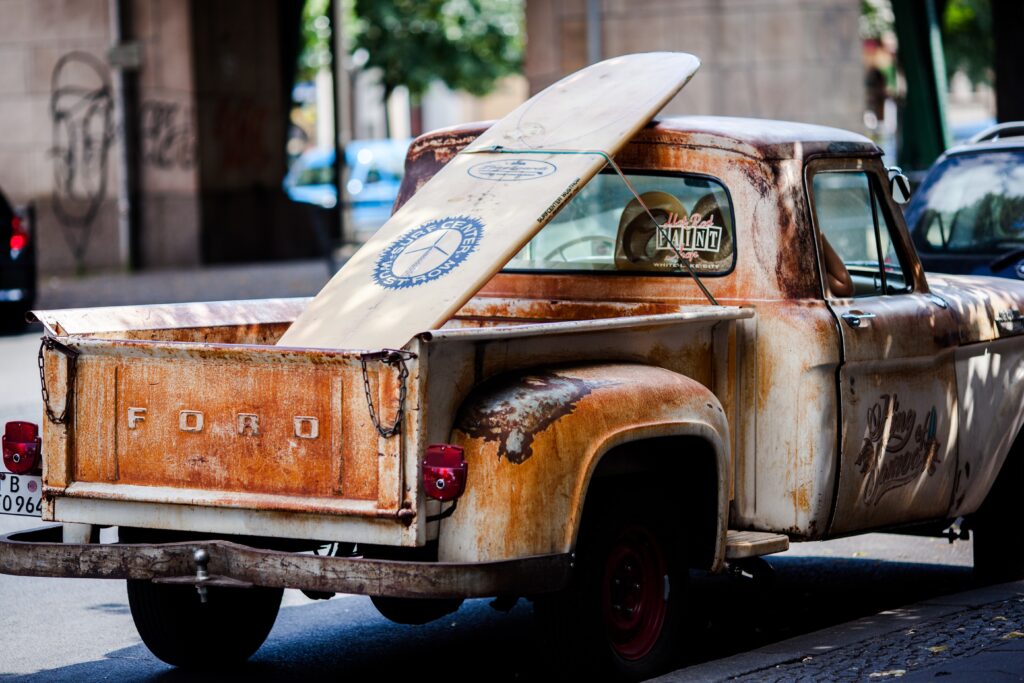

Used surfboards should be free of wax and stickers when inspected so that any damage can be better recognized, as most used surfboards have been damaged in one way or another. You will soon be able to find used surfboards here on the Stoked Zone.
Most surfboards use cores made of polyurethane (PU) with polyester resin or cores made of expanded polystyrene (EPS) with epoxy resin. Epoxy resin is more resistant than polyester resin and EPS foam has more buoyancy than PU foam.
You don’t need to worry about small dents without cracks in the PU core. 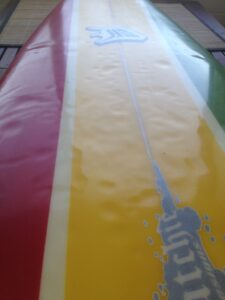
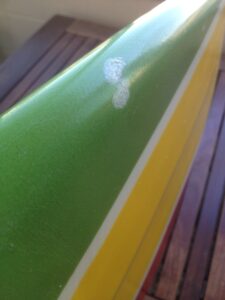
You should always repair deeper cracks in the laminate regardless of the construction method, or temporarily cover them with waterproof tape if you want to take the newly purchased board into the water.
Broken boards that have been reassembled should be treated with caution. You should be convinced of the professional repair before you commit to a purchase. The price for a surfboard repaired in this way should also convince you. Please also bear in mind that these surfboards can be heavier and have lost some of their stability. The same applies to damage to fin boxes.
Damage that has been repaired by the previous owner should be checked more carefully. When repairs are carried out professionally, you can hardly see anything of the damaged area.
When carrying out repairs, you should always make sure that you use the right resins for the respective construction method (PU/EPS)! Resins specially designed for surfboard repair should always be used. Resins from DIY stores or the Internet that are intended for other purposes are not always UV-stabilized and yellow very quickly. Use polyester resin to repair a surfboard with a PU foam core and epoxy resin for a surfboard with an EPS foam core. If the construction method is unknown, you should use epoxy resin.
You should definitely remember that the leash on your surfboard can be a kind of life insurance. That’s why we always recommend buying a new leash for used surfboards and never buying a used leash.
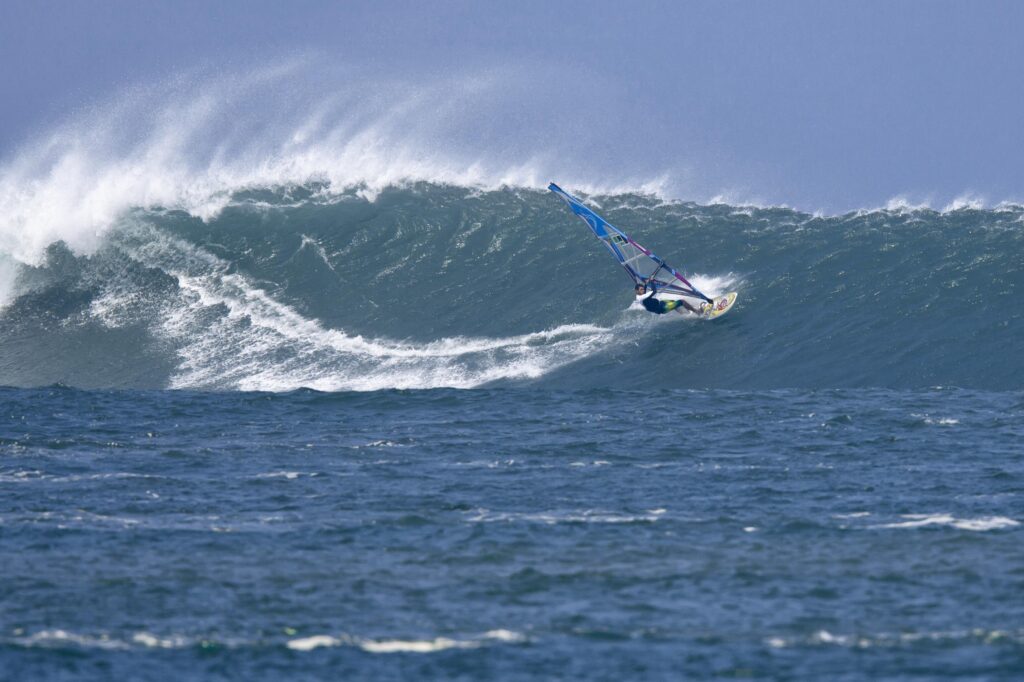
With windsurfing boards, you should take a close look at any damage, even minor damage. Due to the design (water-absorbing foam core), even a small crack through the laminate is sufficient for the foam core to absorb water. Getting the board dry afterwards is a challenge in itself. Used but already repaired boards should be weighed to check whether there is any water in the board.
Windsurf boards are laminated with epoxy resin and epoxy resin is used for repairs. Larger damages should be laminated. This way you are on the safe side and don’t have to worry about repaired areas breaking open again under load.
Certain areas of windsurf boards are critical when damaged and should only be repaired by a specialist. These include:
1. soft spots or damage in the stand area
2. cracks or soft spots under the pads, on the rails, as well as on the mast track or fin boxes
3. major damage to the shell and core
When buying used surf sails, you should use the following questions to assess the condition of the surf sail:
Is the cap and the rope for the mast on the sail top in order?
Is the pulley for the luff and its attachment to the sail undamaged?
Small faults on the surf sail do not necessarily have to be the reason not to buy this sail. However, it should be taken into account in the price offered, because very few of us will have the appropriate sewing machine for a sail repair at home, and a repair may have to be commissioned. A repair of this kind can quickly cost more than €100. Ask a sailmaker about the cost of a repair before you buy a damaged surf sail. This will also help you to negotiate a good price with the seller.
Smaller cracks should be covered with tape to prevent cracks from spreading and causing even greater damage.
In general, small tears in the monofilm can be repaired permanently and inexpensively with good tape.
Tip: If you use transparent tape, there will be no beauty deficit in your surf sail.
You can also buy used masts, but there are a few things to bear in mind here too:
We strongly advise against buying a mast that has been repaired on the laminate or carrying out such repairs yourself, as there is a risk of the mast breaking. We can confirm from our own experience that a broken mast, especially far from the shore, can be a major safety risk.
You should assess a used boom based on the following questions:
As with the mast, we advise against buying a boom that has been repaired at the spars for safety reasons.

You can also buy kite equipment and used surfboards for kiting second-hand, but please note the following points:

The first question you should ask yourself is whether you want a hardboard (fixed board) or an inflatable SUP.
The following questions and points should help you:
Are there any damages or already repaired areas, if so have these been professionally repaired?

The question of whether you should buy a used wetsuit is difficult to answer. In principle, there is nothing to be said against it, but not everyone feels comfortable with it. If you belong to the second group, you should spend a little more money and buy a new suit so that nothing stands in the way of your next surf session.
The following questions should help you check used wetsuits:
If in doubt, we recommend that you spend a little more money and buy material that can be used extensively and possibly resold later.
Have a look under “Classified Ads” on the Stoked Zone to see if you can find the right used surf equipment for you.

Hamburg, 17.11.2024 – After successfully participating in surf festivals in the north of Germany (Fehmarn) and a trade fair in the south,
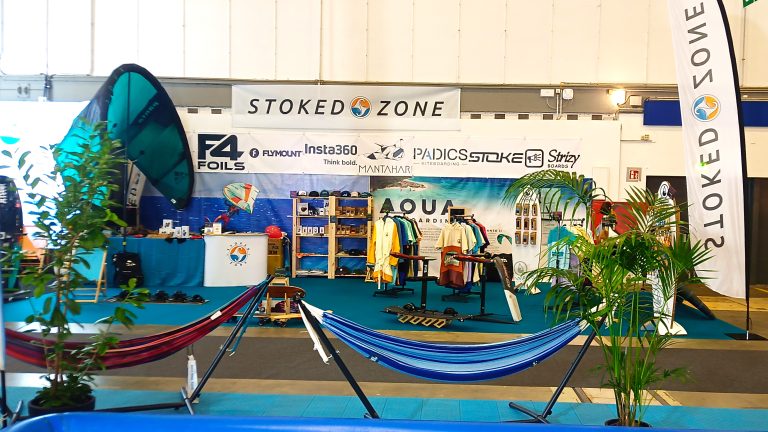
Hamburg, 10.12.2024 – Boot & Fun Berlin was another success for the development of the Stoked Zone as a platform for surf sports

Hamburg 25.11.2024 We are very pleased to announce our partnership with the premium surfskate brand Curfboard.Curfboard is a German company with a